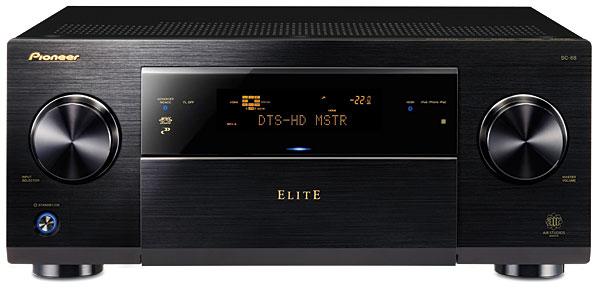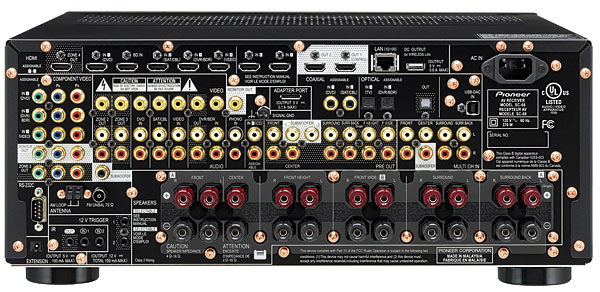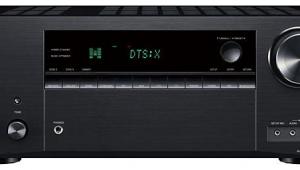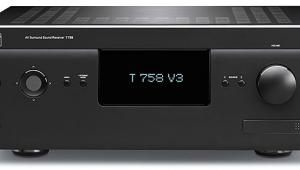WOW. Drool Drool Drool...not sure about the WF (Wife Factor)...
Pioneer Elite SC-68 A/V Receiver

Like a parent who charts a child’s growth with colored pencil marks on the wall, I’ve been observing the growth of audio/video receivers since the beginning of the product category. The wall is covered with ascending marks: Here’s the first A/V receiver, with composite video switching and no surround processing. Here’s the first Dolby Surround model, the first Dolby Pro Logic model, the first Dolby Digital model—and the first with DTS, THX, lossless surround, room correction, satellite radio, HDMI, network audio, Apple everything.
By my reckoning, Pioneer receivers have seen some remarkable growth spurts in the last few years: The pencil marks still rise ever upward. The SC-68, scion of the upper-crust Elite line, uses a new generation of switching amplification Pioneer calls D3. And the feature roster is as long as a mobster’s rap sheet. It has virtually everything a receiver could possibly have, plus a few things no one but Pioneer has, such as AIR Studios Monitor Certification.
What stretches the distance between the pencil marks even farther is this receiver’s USB DAC, which can accept direct input from a computer, essentially turning the receiver into a 32-bit, 192-kilohertz, asynchronous, jitter-busting, digital-to-analog conversion machine, one that can turn a chaotically clocked bitstream into something musical. In theory, this might put Pioneer in the same category as the high-end USB component-DAC makers, and I can just hear those guys chiming in with something along the lines of “like hell it does.”
D to the Third Power
D3 is the third generation of Pioneer’s switching amplification strategy. Pioneer’s implementation of Class D, based on ICEpower modules, made its debut in the Elite SC-09TX, which cost $7,000 when Tom Norton reviewed it in 2008. Later and lower-priced versions went on to claim raves from Michael Fremer in 2009 in his review of the SC-07, and again in 2011 with the SC-57, which saw the first introduction of D3. Class D, in general, is more energy efficient than the Class AB used in most receivers because it dissipates less energy in the form of heat. Pioneer says D3 uses 44 percent less energy than its previous version of Class D, and 50 percent less than Class AB, while providing a wider dynamic range and supporting speaker impedances down to 4 ohms, even when more than one zone is operating. My review sample ran warm but not hot. The amp also benefits from a newly designed heat sink, discrete seven- and nine-channel inputs, and more direct signal paths, eliminating EMI filtering, feedback loops, impedance selectors, and current limiters. Pioneer says this reduces coloration, ringing, and noise, especially at high frequencies.
Just 7.25 inches tall, this 9.2-channel receiver is rated at 140 watts into 8 ohms with two channels driven. Surround is at heart a 5.1-channel medium, so you have two extra pairs of amp channels to play with, plus provision for a second sub. You might use the extra amp channels to run front-height and back-surround speakers simultaneously. But they have other potential uses, including biamplification of the front left/right channels and multiple zones. Mix and match to your heart’s content: This receiver will let you set up to 10 output configurations. And it facilitates multiple wiring schemes, with 11.2-channel preamp outs and 11 sets of binding posts. If you like having high def in more than one place, note that one of the four zones is associated with an HDMI output, another with component out, and two more with composite outs—so half the total is HD capable.

Most manufacturers say their products are great, but few can point to multiple sources of credible outside certification. The SC-68 is an exception: Pioneer’s top-end models are the only receivers “mastered,” as the company likes to say, at AIR Studios in London. That means the prototype’s sound was evaluated and tweaked by Sir George Martin’s henchmen until it earned AIR Studios Monitor Certification. The receiver is also THX Ultra2 Plus certified, meaning it can produce sound pressure levels of up to 105 decibels in a room of up to 3,000 cubic feet when mated with THX Ultra2–certified loudspeakers.
Though Pioneer rolls its own auto setup and room correction system, the resulting MCACC (Multi-Channel Acoustic Calibration) ranks with the best licensed competitors. This receiver lets you select Full Auto MCACC; Auto MCACC, which lets you customize some setup options; and Manual MCACC, which allows still more setup options for the advanced user. Running Full Auto MCACC will also invoke Pioneer’s Full Band Phase Control, which adjusts group delay in an attempt to keep your system’s unruly woofers and tweeters coordinated in the time domain. It can be switched on or off separately from MCACC using a dedicated remote button.
Want to get music from your smartphone or tablet into the receiver? Pioneer offers multiple wireless and wired paths. Prominent among them is Apple AirPlay. It’s oh so easy to use: Just enable Network Standby in the GUI. But you’re not limited to that. Pioneer now supports the HTC Connect standard for music streaming from HTC One smartphones, pushing album art and metadata to the video display. This receiver accommodates MHL (Mobile High-definition Link)–compatible devices via the front-panel HDMI jack—and it’s noteworthy that MHL has at least the potential to offer better-than-CD resolution. The receiver also offers Bluetooth support with the optional AS-BT100 adapter ($99). Note that many Apple devices support Bluetooth in addition to proprietary AirPlay. There’s also DLNA 1.5 support for a router-connected computer. If running an Ethernet cable to the receiver is inconvenient, get the optional AS-WL300 adapter (price knocked down from $149 to $129). It’ll be easier to configure if your router has WPS protection. Mine has old-fashioned WEP, so I settled for Ethernet.
- Log in or register to post comments



I own the Elite SC-57, well atleast until yesterday. I sold it and picked up an sc-68 after reading this review. I loved everything about the Sc-57. The sound was just amazing. I had it paired up with the Jamo D600 THX ultra 2 system( I think home theater.com needs to review this system :) ). In fact, i just opened up my SC-68, will give you guys a comparison in about 2-3 days.


I just picked up the SC-55. I've used air play, iPod connected through the usb (better) and an older CD player as sources.
Not quite satisfied, I started looking at ways to use the other lossless codecs supported by the SC-55 via network streaming.
I'm now using the JRiver Media Center software to manage and stream flac and wav files to the SC-55 from my laptop. The sound is AMAZING. Love it.
Downloaded the HDtracks sampler pack. It is a great introduction to their extremely high quality tracks. Their process makes a huge difference in the detail that you hear.

It seems almost every receiver in this price range has HD radio, except for the Pioneer. It's a feature I would like to have and am leaning against this receiver because of that. Am I crazy?

Mark, do you foresee more impedance options becoming mainstream or available to low/mid-level home theater products with the integration of more Class D amplification? I am still newer to home theater but have been a car audiophile for a while and have always enjoyed the numerous power options available. Is my perception that it is cheaper for a manufacturer to make an amplifier with lower impedance incorrect? To power a car audio subwoofer at 8 ohms would be much more costly for me to power than 4 ohms - what am I missing?


Thanks for the reply Mark. Now it's time to do what the first commenter said and start kissing up to my wife so she eventually sees reason - that it's time to upgrade receivers and it will benefit her as well :)

Mark,
Please tell me where you rate this in relation to the Arcam AVR600 or 400.
I'm in the market and REALLY don't have money to throw away.
The reviews on the Arcam stuff is over the top! And until I read this, I would not have ever CONSIDERED the Pioneer. That takes me back to my early days of stereo. Pioneer, Kenwood, Sansui and the like.
But names don't really mean anything. It's performance that counts. Being able to listen and enjoy for long hrs at a time.
Do you think this Pioneer has sonics like the Arcam?
Help,
Thanks!


Hello Mark, what is your thoughts on the SC09 in comparison to the Arcam 600? I have a chance at both, and I would love some good feed back regarding these two from your perspective.
Thank you kindly.
Tom.

Mark or Rob,
I'm a little confused about the somewhat higher-than-usual distortion percentage in the frequency response. The previous generation measured significantly lower in distortion, bottoming out at a very impressive < .002%, where this receiver strangely stops at around .04%. Is that a big deal? Any ideas why it would behave so differently? The entire trace on the graph looks strange to me, unlike any Pioneer class D I've ever seen. I would be interested to hear what you think
Thanks.

The other thing that contributed significantly to the sound quality was the involvement of the personnel at Sir George Martin's AIR Studios, who consulted on the sonics throughout the development.
Two channels driven continuously into 8-ohm loads:
0.1% distortion at 144.5 watts
1% distortion at 191.6 watts
Five channels driven continuously into 8-ohm loads:
0.1% distortion at 92.3 watts
1% distortion at 138.8 watts
Seven channels driven continuously into 8-ohm loads:
0.1% distortion at 90.0 watts
1% distortion at 113.8 watts

Rob,
Thanks for the reply. Yes, its definitely true. Even the best sounding tube amplifiers have higher distortion than the Pioneer, and MANY audiophiles wax poetic about their virtues. (Unfortunately, I haven't heard a single one.) So, I'm more than willing to give it a listen when I can, as I'm looking to replace my first generation class D SC-09. I was just surprised to see the change in response of that one parameter, where the SC-57 absolutely excelled.
This begs another question: How does it compare to my first gen SC-09? Certainly less power, but the sonics? Any thoughts on that as well?
Thanks again.
Jerry

Thanks Mark for your reply about the Pioneer vs Arcam.
I'm going for the Arcam ~~ wih some fear ~~
Do you think they've cleared up the problems/bugs??

I own the Arcam 600. I have been using it for a about 1.5 years now. In regards to questions about bugs, yes for the most part everyting has been cleared up. There are still some minor things that still need to be resolved but otherwise it's been an amazing receiver. The only major caveat I have is the fan which is loud for my taste. However, when running 120 watts to each of 7 channels it's not surprising.
All this being said if I was buying a one today, in addition to this Pioneer, and if you are considering spending 5k, I would give a listen to the new NAD receivers, as well as the Anthems before making a final decision.

What's about this Pioneer vs Marantz Sr7007 especially in midrange and bass quality? This year I had audtiton Pioneer SCLX56(Europen model) and it's sounds realy bright... A bit similar to Yamaha RX-A2010/3010 which I have and can't stand it any more...
Last thing about class D, Did you test it with demanding speakers like Sonus Faber? What's about volume control? How much do you need to increase volume to get full sound?

From my experience. I think that class D has a much better bottom end and midrange, that's basically what the review talks about. That's one of the strengths of the topology over A/B. The imaging and sound are more spacious, dramatic and powerful. Great for home theater.

I have a dumb question re the USB DAC input. This receiver, as all other AVRs, already has a DAC for all incoming digital audio signals. So what's the significance of the USB DAC? If it weren't there, the incoming USB signal would have to pass through the "regular" DAC anyway, right?
Thanks.

Hi Mark:
I am brand new to the Hometheater.com.
I am intrigued by your comments about DSD capabilities for this receiver, and I was wondering if you could clarify:
DSD Direct is normal for DSD-capable receivers for some time now. You set the SACD/universal player for either PCM or SACD (DSD)via its HDMI output. However, if this Pioneer receiver can also do DSF and DFF files via DoP then this is indeed a first for the AVR category. Can you confirm that this can be accomplished?

Mark or Rob:
I have heard various versions of MCACC's ability to calibrate subwoofers. Some said it cannot whereas some (including Mike in his review of the SC-57) have said it does a fantastic job. Which is it? can you clarify, please? Also, how does the SC-61 compare with the SC-57 (the 68 is out of my budget). Thank you!

Hi Mark,
Great review! I just removed my beloved RSX-1065 from my HT room and replaced it with a SC-1527, which is a Canada only SC-65 minus the elite badge. I had thought of using it as a pre-amp along with the RSX and my RB-1070, but the low end grunt and killer mid range has won me over. It mates with my Atlantic Technology 4400 system beautifully. I was worried that running dual subs would confuse the MCACC, but alas, the software is up to the task. My only gripe is when using zone 2 to drive my AE109 speakers, you must turn off the HT zone, which is speaker selection A, from the front panel. If not, your HT room ends up playing the same source, at the same volume level, as your zone 2 (speaker B) room. From my experiments, and I'm only one week in with the Pioneer, I'll fix this by utilizing an outboard 2 channel amp for zone 2, which leaves me a pair of unused D3 amp channels, being that my HT room is 7 channels. Maybe I'll return it & pick up the SC-63, which as you know is a 7.2 piece. I'm looking forward to your review of the SC-61 also. Keep up the great work guys !!

I have sc-37 it has more power then sc-68 or sc-57 according to home theater stats,only reason for me get the new for 4kby2k tv's whenever they come out,so what about the Denon 4520ci it has great features too,i have 600 series BW's towers and bookshelves speakers,for now im not changing anything.

hi
nice review. can you point in the manual where the bass management with specified crossover FQs are mentioned ??
Didn't find any
also after an auto MACC, can I still determine manually for each speakers, the crossover pt ? as with Yamaha receivers for instance
Manuals for these "hot gas plants" those receivers are should include much more OSD screenshots rather than badly written litterature...
thanks !
Tom

Thank you for the review. I am looking for a receiver and this will be my first foray into the Relatively midrange realm. I was originally only into music, but with a family now, my new system must incorporate movies etc.
I have crunched it down to the Yamaha Aventage and the Pioneer SC-67,68. I have finally decided upon the Pioneer SC-67 mainly because of the AIR certification and video upscaling, but I would like to know what is the major difference between the SC-68 and the SC-67?
Where I live there is a $500-$700 difference between the two systems but I would like to know if anyone has heard a major difference between the two.
Thanks

The thx-mode on square feet and the dacs

The thx-mode on square feet and the dacs and also bi-amping front and rear speakers.

The thx-mode on square feet and the dacs and also bi-amping front and rear speakers and center.

Thank you so much for the response. I think that the question that comes to mind now is whether this difference is worth $500-$700? I can get a relatively good deal from the list price of $2000 for the SC-67 (I have seen $1200 online), but would I be better off going all out for the SC-68? Admittedly I am a Newbie at this and I have not had a stereo system at all in over 4 years since doing a rebuild on my house.
With kids and the hope of having a system for the next 5-10 years am I missing anything that only a High End person would be able to tell the difference? I am resigned to pouring most of my remaining funds into the Receiver and TV, both of which have not yet been purchased.
When I checked the single page spec sheets, apart from what you have mentioned earlier, there seems to be only a few power points separating the two systems. 770 w vs 810 w multichannel. Again, is that worth the money?
Thanks again.
(Mythos fronts, M&K surround back, Martin Logan Dyn 500 subw).
(TV pending, Receiver Pending).

Hi!
After reading this review I'd like to know if it's worth spending more on a Marantz AV7701 with a Parasound Halo A52 amplifier over the Pioneer SC68 alone (in 5.1 mode with front and surround or center bi-amp) to drive my future 5.1 home-theater... Will the sound quality be significantly different between the 2 setups?
I'm also undecided about speaker selection. For about the same cash what would you recommend: Klipsch RF7 II speaker system, Monitor Audio GX300 based system or a KEF R900 based system???
I NEED HELP!
THANKS!

I presently have an Anthem MRX-300 with an Epson 8500UB projector.
I dont believe Anthem is strong in the video processing area.. which has notable effects in my display..
Is the Pioneer better .. honestly.. I want an upgrade in video AND audio quality .. i dont want to sacrifice one for the other..
PLease advise,
Nathan

Nice review, thanks. I'm wondering how the SC-68 might perform as a preamp? Would the top end likely improve since you're bypassing the D power amps?? I'm trying to decide on a preamp for my HT and am currently back and forth between the SC-68 and the Marantz av7701. I need the dual HDMI outs and like the other networking abilities of both. Any other recos are welcome, of course. Thanks again.

Dear Mark many thanks for this excellent and helpful review. I have three questions:
1. I have three speakers (one center and two rear) from an Samsung all inclusive system (receiver plus dvd). I have kept the speakers because they are quite stylish and have not found "proper" replacements. The Samsung receiver was mentioning in it back something about having an output of 3 ohms. I assume thus that the Samsung speakers are 3 ohms each. I am using them with a Sony STR-DB-920 (which has a minimum setting of 4 ohms) and they play just fine (no smoke anywhere at the audio chain!). Do you think (no liability - my own risk etc) that I would have a problem attaching those speakers to the SC-68 (only one zone at the time, 5 speakers max)? Can I do something in order to further protect the system? (e.g. attach additional impedance on the cable?).
2. I have currently connected my pc to the DB-920 through the optical out of my soundblaster. Everything is rooted through this output, including multichannel sound which is recoded as Dolby Digital. If I attach the SC-68 as a usb sound card, will I be able to play directly multichannel sound? I cannot understand the mentioned restriction to flac / mp3 / wav etc. A normal soundcard would play everything as long as you have the proper codecs at a player level. Isn't this teh case with SC-68? What would happen if I open xbmc an play a dts file? Will I have to change the input to optical in? What about multichannel dff files? Can I play them the same way that I play other music on my pc?
3. Can I control the SC-68 with Android? I understand that there is an app for that.
Many thanks,
Evans

All,
We are trying to finalize between Elite SC-61, SC-63 or a Marantz 6007. We listen to stereo music as well as watch movies a lot.
What do you recommend? Please Advise.
Thanks,
Venky

Hi Friends,
Any update? Please let us know.
Thank,
Venky

I enjoyed reading your post and found it to be useful and to the point. Thank you for not rambling on and on just to fill the page.
austin roofing

This conent is simply exciting and creative. I have been deciding on a institutional move and this has helped me with one aspect. Cheers!
1stopprojectmanagement.com

Is there something wrong with the graph?
Even the SC-61 one looks better.

I bought this Pioneer Elite SC-68 A/V Receiver
A few moths back how should I use it with or with out my power amp??
The amp is this The Signature MPA 5150 five-channel reference power amplifier. Any help would be greatly Appreciated.

How come Pioneer does not include HD Radio.


























































